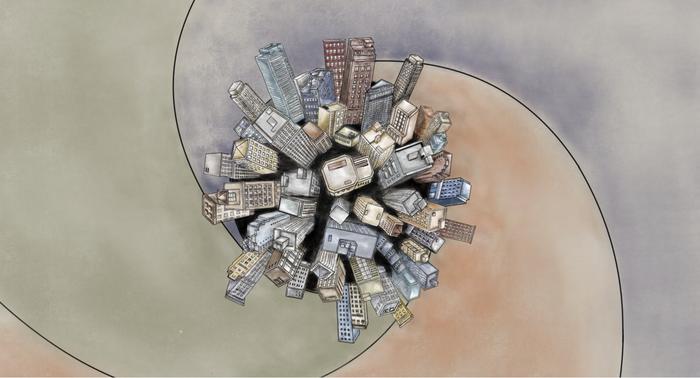More than half of the world’s population—4.4 billion people—lives in cities, and that proportion will grow to two-thirds by the year 2050, according to the United Nations.

Credit: Image by by Elisa Heinrich Mora, with inputs from Katie Mast, Abha Eli, and Mingzhen Lu.
More than half of the world’s population—4.4 billion people—lives in cities, and that proportion will grow to two-thirds by the year 2050, according to the United Nations.
As the world’s population expands, and becomes increasingly urbanized, many have raised concerns about the impact of waste—from house trash to wastewater to greenhouse gas emissions—on the planet.
“We as a society tend to ignore the unpleasant side of our production,” says Mingzhen Lu, an assistant professor at New York University’s Department of Environmental Studies.
However, while both waste and urbanization increase each year, less certain is the magnitude of waste generated by cities and the nature of its growth.
To address these matters, Lu and Chris Kempes, a professor at the Sante Fe Institute, and their colleagues examined waste production in urban systems. Specifically, the authors used scaling theory to analyze waste products—municipal solid waste, wastewater, and greenhouse gas emissions—from more than 1,000 cities around the world. Scaling theory, which describes how changes in the size of systems impact a range of system properties, has been used to elucidate phenomena in urban systems—such as the accelerating wealth creation as cities get bigger—so is a suitable means for understanding how waste production scales with the growth of a city.
“The key question is whether waste is produced more or less efficiently as systems scale up, and how big a recycling burden there is as a consequence,” says Kempes.
Their findings, which appear in the journal Nature Cities, showed distinct differences in waste production as cities grow.
Specifically, their analysis revealed that solid waste scales linearly; because it is tied to individual consumption, it increases at the same rate as population growth. By contrast, wastewater production scales superlinearly—at a faster than linear rate—while emissions scale sub-linearly, or at a slower than linear rate. So, when cities double in size, the generation of their greenhouse gas emissions increase at less than double the rate of their population growth, suggesting bigger cities, on average, are more energy efficient but less water efficient.
Their analysis also showed that cities with a higher per-capita GDP generate more waste, which underscores the strong bond between waste generation and economic growth.
The researchers conclude that, overall, more waste generation seems to be a natural consequence of economic growth. To address this, the authors argue for a “break up” of economic growth and waste generation, an unavoidable path to urban sustainability but one already adopted by some cities.
For instance, two decades ago, San Francisco implemented a long-term goal of zero waste and has sought to achieve it through increased recycling and composting—sustainable methods of waste that would otherwise go to landfills. Seoul has adopted a similar approach and now recycles nearly all of its food waste.
Moving forward, Lu expressed his inspiration to contribute to this endeavor of urban sustainability by learning from nature.
“Examining how cities generate waste is only the first step,” he says. “We eventually need to figure out a way to close the material loop. Natural ecosystems and the organisms within, being the early multicellular life or the ancient wood-decaying fungi, have figured out how to deal with nature’s waste for millions of years. We can too.”
# # #
Journal
Nature Cities
DOI
10.1038/s44284-023-00021-5
Method of Research
Data/statistical analysis
Article Title
Worldwide scaling of waste generation in urban systems
Article Publication Date
17-Jan-2024




